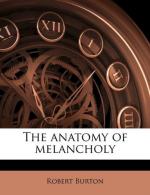I find a vast chaos of medicines, a confusion of receipts and magistrals, amongst writers, appropriated to this disease; some of the chiefest I will rehearse. [4260]To be seasick first is very good at seasonable times. Helleborismus Matthioli, with which he vaunts and boasts he did so many several cures, [4261]"I never gave it” (saith he), “but after once or twice, by the help of God, they were happily cured.” The manner of making it he sets down at large in his third book of Epist. to George Hankshius a physician. Walter Bruel, and Heurnius, make mention of it with great approbation; so doth Sckenkius in his memorable cures, and experimental medicines, cen. 6. obser. 37. That famous Helleborisme of Montanus, which he so often repeats in his consultations and counsels, as 28. pro. melan. sacerdote, et consil. 148. pro hypochondriaco, and cracks, [4262] “to be a most sovereign remedy for all melancholy persons, which he hath often given without offence, and found by long experience and observations to be such.”
Quercetan prefers a syrup of hellebore in his Spagirica Pharmac. and Hellebore’s extract cap. 5. of his invention likewise ("a most safe medicine and not unfit to be given children”) before all remedies whatsoever. [4263]
Paracelsus, in his book of black hellebore, admits this medicine, but as it is prepared by him. [4264]"It is most certain” (saith he) “that the virtue of this herb is great, and admirable in effect, and little differing from balm itself; and he that knows well how to make use of it, hath more art than all their books contain, or all the doctors in Germany can show.”




